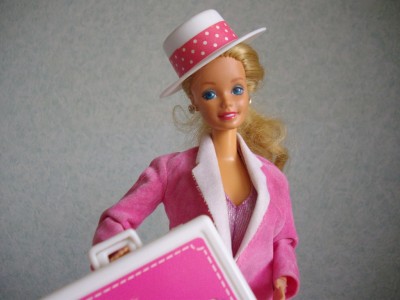
On March 9, 1959, “Barbie” was born. Since then, “It is estimated that over a billion Barbie dolls have been sold worldwide in over 150 countries, with Mattel claiming that three Barbie dolls are sold every second.” (Wikipedia)
The iconic doll which has become symbolic of the unique American materialistic culture has been the object of both communal desire and controversy. The doll’s critics have claimed, “the doll gave girls misguided goals” (NY Times 4/29/02). And in Saudi Arabia, they have “outlawed the sale of Barbie dolls, saying that she did not conform to the ideals of Islam. The Committee for the Propagation of Virtue and Prevention of Vice stated, ‘Jewish Barbie dolls… are a symbol of decadence to the perverted West.’” (Wikipedia)
Interestingly enough, the doll indeed is a “Jewish Doll”. The doll was created by Ruth Handler, a Jewish woman from Denver who was married for over 60 years to Izzy (Elliot) Handler. She designed the doll in 1959 and it debuted on March 9, 1959 at the American Toy Fair in New York City. As the saying goes, “the rest is history.”
Eventually Barbie, who was named after the Handlers’ teenage daughter Barbara, would have a male companion, Ken, who was named after the Handlers’ son Ken. The success of Barbie forced the company to hire a secretary for the doll to answer twenty thousand fan letters a week. By 1968, the Barbie Fan Club grew to 1.5 million members in the United States. Barbie is seemingly an American success story as the daughter of Jewish immigrants became a multimillionaire in the land of opportunity.
Why is Barbie so popular?
Why is this doll the “must have” toy for so many little girls?
The answer was provided by Mrs. Handler herself. “My whole philosophy of Barbie,” she said, “was that through the doll, the little girl could be anything she wanted to be.”
With a little imagination, the doll became the vicarious life of its owner. Suddenly the little girl could – through Barbie – transport and transform herself to glamourous and exciting life situations which seemed preferable to the life she had. I am not going to comment on the desirability of this doll offering vicariously a glamour-filled life of luxury and fun for any little
girl.
And I agree with Mrs. Handler that we all should have dreams; and I admire her business acumen and her philanthropy to Jewish causes. However, the question I pose is, “What do we want our children to dream about?”
The Gemara in Brachos (55a) informs us that a person should daven to Hashem that he or she has “good dreams”; however, what are good dreams?
Do we dream of luxury homes and fancy clothes and designer outfits as Barbie possesses? Or do we dream to help other people and impact this world with chessed and with compassion? Besides March 9th being the birthday of Barbie; this year, the same day was also the yahrtzeit of Rav Moshe Weber zt”l who passed away in 2000.
Who was Rav Moshe Weber?
Did you ever go to the Kotel in your life? Did you notice the stand on the left side of the men’s section where hundreds of Jews (especially soldiers) stop daily to put on Tefillin?
That stand was personally set up and manned by Rav Moshe Weber after the 1967 war. Although Rav Moshe was a Chabad chassid, originally this was not an official Chabad outpost. It was the personal brain-child of one caring and concerned Jew. Rav Moshe Weber was a Yerushalmi Chabadnik who was born in Yerushalayim in 1914.
He lived in Meah Shearim, and although he and his wife had no biological children, their home became a center for anyone, observant or not, who needed a meal. He was known as the “go-to” person when someone wondered into Meah Shearim in search of a meal. He loved all Jews and devoted his life to helping others. Rav Moshe Weber’s father passed away in 1916 when Rav Moshe was only two years old. It must have been difficult for an orphan during World War I to dream. The famine in the city was rampant. Spiritually, the city was in decline and here was a fatherless little boy alone and hungry.
Yet, Rav Moshe had dreams.
He had dreams of feeding hungry people when he would have the wherewithal to do so. He had dreams of helping Jews connect back to their roots and eventually he would stand for hours at the Kotel encouraging men to don Tefillin.
I have warm and wonderful memories of Rav Moshe at his post at the Kotel, a smile always present on his angelic face. He dreamed and he accomplished. He never achieved the fame and wealth of Mrs. Handler. He never had a secretary like Barbie did to answer twenty thousand letters per week.
His obituary never made the New York Times. Yet, his dreams also became a reality and his dreams were fulfilled. At the end of the day, how many lives have been improved through Barbie and how many through the chessed of Rav Moshe Weber? Whose legacy is more precious – Barbie’s or Rav Moshe Weber’s? I think you know my answer.
Photo Credit: Freddycat1



















